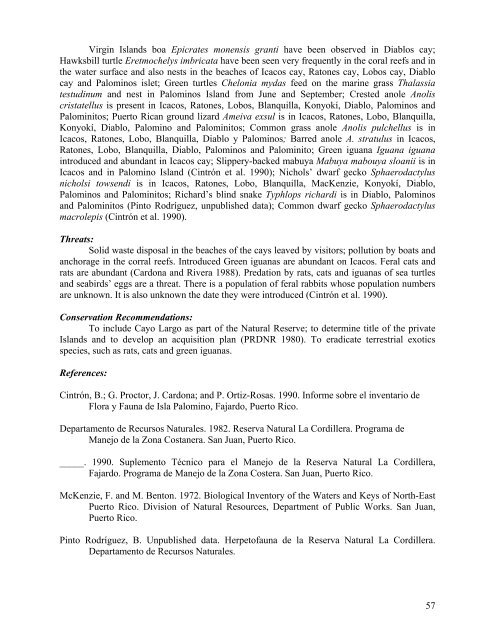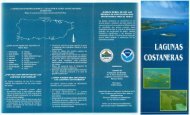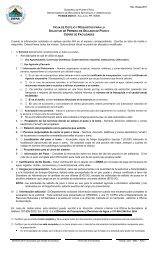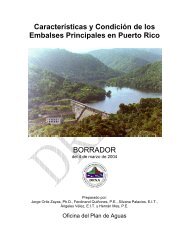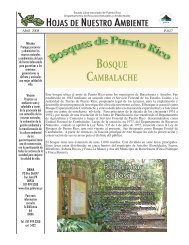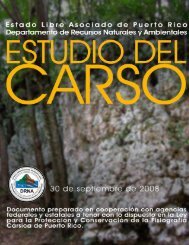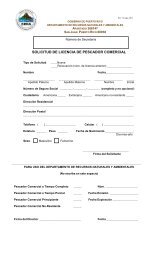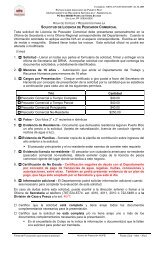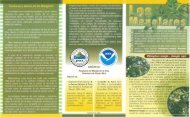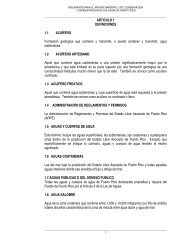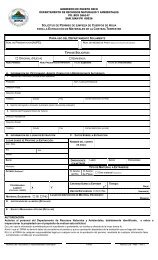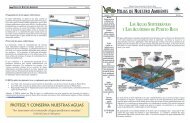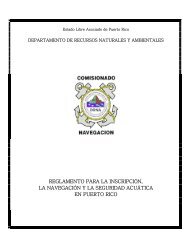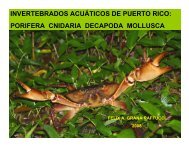Puerto Rico Critical Wildlife Areas - Puerto DRNA - Gobierno de ...
Puerto Rico Critical Wildlife Areas - Puerto DRNA - Gobierno de ...
Puerto Rico Critical Wildlife Areas - Puerto DRNA - Gobierno de ...
Create successful ePaper yourself
Turn your PDF publications into a flip-book with our unique Google optimized e-Paper software.
Virgin Islands boa Epicrates monensis granti have been observed in Diablos cay;<br />
Hawksbill turtle Eretmochelys imbricata have been seen very frequently in the coral reefs and in<br />
the water surface and also nests in the beaches of Icacos cay, Ratones cay, Lobos cay, Diablo<br />
cay and Palominos islet; Green turtles Chelonia mydas feed on the marine grass Thalassia<br />
testudinum and nest in Palominos Island from June and September; Crested anole Anolis<br />
cristatellus is present in Icacos, Ratones, Lobos, Blanquilla, Konyokí, Diablo, Palominos and<br />
Palominitos; <strong>Puerto</strong> Rican ground lizard Ameiva exsul is in Icacos, Ratones, Lobo, Blanquilla,<br />
Konyokí, Diablo, Palomino and Palominitos; Common grass anole Anolis pulchellus is in<br />
Icacos, Ratones, Lobo, Blanquilla, Diablo y Palominos; Barred anole A. stratulus in Icacos,<br />
Ratones, Lobo, Blanquilla, Diablo, Palominos and Palominito; Green iguana Iguana iguana<br />
introduced and abundant in Icacos cay; Slippery-backed mabuya Mabuya mabouya sloanii is in<br />
Icacos and in Palomino Island (Cintrón et al. 1990); Nichols’ dwarf gecko Sphaerodactylus<br />
nicholsi towsendi is in Icacos, Ratones, Lobo, Blanquilla, MacKenzie, Konyokí, Diablo,<br />
Palominos and Palominitos; Richard’s blind snake Typhlops richardi is in Diablo, Palominos<br />
and Palominitos (Pinto Rodríguez, unpublished data); Common dwarf gecko Sphaerodactylus<br />
macrolepis (Cintrón et al. 1990).<br />
Threats:<br />
Solid waste disposal in the beaches of the cays leaved by visitors; pollution by boats and<br />
anchorage in the corral reefs. Introduced Green iguanas are abundant on Icacos. Feral cats and<br />
rats are abundant (Cardona and Rivera 1988). Predation by rats, cats and iguanas of sea turtles<br />
and seabirds’ eggs are a threat. There is a population of feral rabbits whose population numbers<br />
are unknown. It is also unknown the date they were introduced (Cintrón et al. 1990).<br />
Conservation Recommendations:<br />
To inclu<strong>de</strong> Cayo Largo as part of the Natural Reserve; to <strong>de</strong>termine title of the private<br />
Islands and to <strong>de</strong>velop an acquisition plan (PRDNR 1980). To eradicate terrestrial exotics<br />
species, such as rats, cats and green iguanas.<br />
References:<br />
Cintrón, B.; G. Proctor, J. Cardona; and P. Ortiz-Rosas. 1990. Informe sobre el inventario <strong>de</strong><br />
Flora y Fauna <strong>de</strong> Isla Palomino, Fajardo, <strong>Puerto</strong> <strong>Rico</strong>.<br />
Departamento <strong>de</strong> Recursos Naturales. 1982. Reserva Natural La Cordillera. Programa <strong>de</strong><br />
Manejo <strong>de</strong> la Zona Costanera. San Juan, <strong>Puerto</strong> <strong>Rico</strong>.<br />
_____. 1990. Suplemento Técnico para el Manejo <strong>de</strong> la Reserva Natural La Cordillera,<br />
Fajardo. Programa <strong>de</strong> Manejo <strong>de</strong> la Zona Costera. San Juan, <strong>Puerto</strong> <strong>Rico</strong>.<br />
McKenzie, F. and M. Benton. 1972. Biological Inventory of the Waters and Keys of North-East<br />
<strong>Puerto</strong> <strong>Rico</strong>. Division of Natural Resources, Department of Public Works. San Juan,<br />
<strong>Puerto</strong> <strong>Rico</strong>.<br />
Pinto Rodríguez, B. Unpublished data. Herpetofauna <strong>de</strong> la Reserva Natural La Cordillera.<br />
Departamento <strong>de</strong> Recursos Naturales.<br />
57


